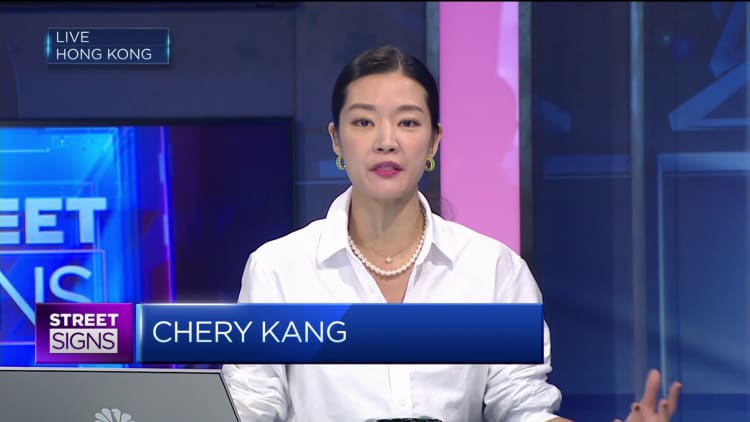The Samsung Galaxy S24 Ultra. The device looks a lot similar to Samsung’s Galaxy S23 Ultra. The main difference this time round is what’s inside: Samsung is going big on artificial intelligence.
Samsung
Samsung announced its new flagship Galaxy S24 smartphone range Wednesday, earlier than expected, touting new artificial intelligence features as the company looks to kick off 2024 with a bang.
As is standard with Samsung’s flagship range now, the S24 range comes in three versions: the S24, S24+, and S24 Ultra. The S24 starts at a price of $1,300, the S24+ will cost $1,000, and the S24 will retail at $800.
The South Korean electronics giant showed off the new gadgets at its Kings Cross offices in London earlier this week, prior to the announcement. At a briefing with reporters, Samsung talked up the phone’s AI capabilities and showed how it’s able to edit pictures and search for items by using AI.
The company is using its own Exynos chipset for its S24 and S24+ models. But for Samsung’s top-tier S24 Ultra, which is the company’s biggest of the three devices and comes with punchier specs and features, Samsung is using Qualcomm’s latest Snapdragon Series 8 Gen 3.
“The Galaxy S24 series devices, together with Google’s Pixel range, mark the dawn of the consumerisation of AI in smartphones,” Ben Wood, chief analyst at CCS Insight, told CNBC. “This is a trend that will be echoed by all smartphone makers, including Apple, as they increasingly add a growing number of AI-powered capabilities to their new devices.”
“This launch sees Samsung betting on features powered by artificial intelligence to reignite consumers’ interest in smartphones at a time when incremental hardware updates have seen sales slow. Google has been the trailblazer with its Pixel devices and there is little question this is going to be a recurring theme going forward, not just for smartphones but across all consumer electronics.”
AI is the name of the game
The Samsung Galaxy S24 Ultra is the of the main event for most tech gadget enthusiasts — and, for the most part, it isn’t a whole lot different to the Galaxy S23 Ultra looks-wise.
That’s because Samsung isn’t changing an awful lot with the hardware. It still comes in the same size as its predecessor — the display is 6.8 inches, measured diagonally, though the phone is flatter this time round. The S23 Ultra had more curvature to it.
The big upgrade to the external hardware with this model is that it’s cased in titanium, so it’s a lot sturdier than the S23 Ultra.
The main difference this time round is what’s inside: Samsung is going big on artificial intelligence. A key focus for Samsung, like other smartphone makers, now is on “on-demand” AI — or, the ability to carry out AI workloads directly on a device, rather than over the cloud.
The Samsung Galaxy S24 Ultra has a bright display that can reach 2,600 nits at peak brightness — making it gthe brightest on a Samsung phone to date, according to the company.
Samsung
Samsung said its new Galaxy S24 Ultra will come with a bunch of new AI features, a lot of which is being powered by Qualcomm’s Snapdragon 8 Gen 3 chipset for mobile, which is tailored for AI devices.
It signals something that a lot of smartphone makers have been focusing on recently. Consumers aren’t getting as excited by new smartphone upgrades as they used to. So phone makers have had to come with ideas to get people’s attention again and rev up excitement in the market.
One feature Samsung’s loading into the Galaxy S24 range is the ability to circle locations or items a user is directing their camera at, or on a picture they’ve taken, and then look up results on what those things are.
So, for instance, if you see a landmark or a shoe you want to buy, you can make a circle around that object and then the AI shows you appropriate results on Google.
Another feature Samsung touted is the ability to use AI to edit photos. So users can edit reflections out of pictures they’ve taken, for instance if you took a picture of yourself in front of a window. Or you can move a person from one side of the room to another by dragging them from left to right.
Samsung also showcased live transcription features with its latest smartphones.
When calling someone who’s speaking in French, for instance, a user can pull up a transcription that’s being fed through to them in real time. You can also record a conversation between two people and get it transcribed, while the AI assigns a label to each person speaking, similar to transcription products like Otter AI.

Paolo Pescatore, PP Foresight, told CNBC that Samsung “must focus its efforts on retaining its core loyal premium base.”
“Arguably [Samsung] has done more than enough with the new features powered by its own AI platform,” Pescatoer said. “This potentially could be the start of a new era for smartphone representing a key super cycle for Samsung.”
“With this in mind, Samsung will have to entice users with a range of competitor offers to suit everyone; this includes older Samsung owners who will inevitably be looking for a much needed upgrade.”
AI watermarking
Another thing Samsung’s had to think about is what its AI features mean for things like privacy and copyright infringement.
The past year has seen countless examples of people using AI to create images and other creative media and pass it off as their own work — even when, in some cases, it’s derivative from or even looks identical to artists’ work.
So when a Galaxy S24 user uses AI to modify a photo, Samsung will keep a log of what was changed with AI and store it in the metadata. It’ll also have an icon in the bottom left corner to show that teh image has been edited using AI, kind of like a watermark.
At the Samsung briefing in King’s Cross, some analysts and reporters were able to crop this icon out just by using Samsung’s in-app cropping feature — though the icon is still kept in the metadata.
“AI-powered image and video manipulation raises some ethical questions, particularly given the recent media attention around deep fake content,” Wood told CNBC. “The addition of a watermark and updated metadata for altered content is a constructive step by Samsung and I’m sure others will follow.”
“The success of Samsung’s AI-based features will largely depend on Samsung’s ability to raise consumer awareness and engagement via its marketing for the Galaxy S24 portfolio,” he added. “Success will require crisp communication of the benefits and continued expansion of the use cases.”







